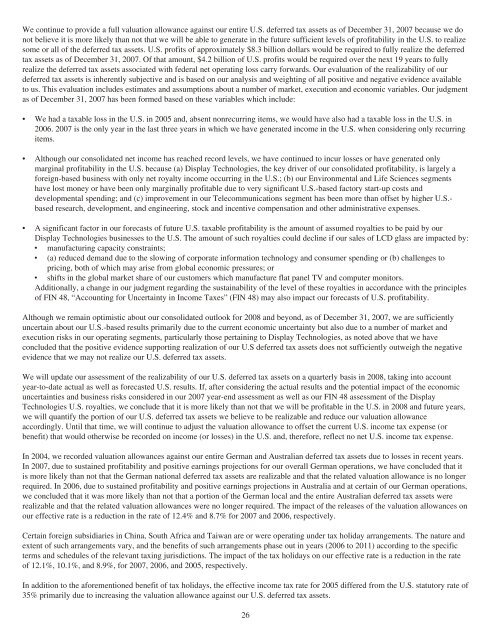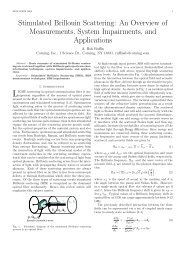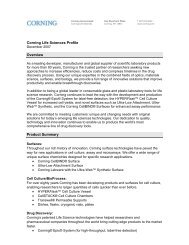Create successful ePaper yourself
Turn your PDF publications into a flip-book with our unique Google optimized e-Paper software.
We continue to provide a full valuation allowance against our entire U.S. deferred tax assets as of December 31, <strong>2007</strong> because we do<br />
not believe it is more likely than not that we will be able to generate in the future sufficient levels of profitability in the U.S. to realize<br />
some or all of the deferred tax assets. U.S. profits of approximately $8.3 billion dollars would be required to fully realize the deferred<br />
tax assets as of December 31, <strong>2007</strong>. Of that amount, $4.2 billion of U.S. profits would be required over the next 19 years to fully<br />
realize the deferred tax assets associated with federal net operating loss carry forwards. Our evaluation of the realizability of our<br />
deferred tax assets is inherently subjective and is based on our analysis and weighting of all positive and negative evidence available<br />
to us. This evaluation includes estimates and assumptions about a number of market, execution and economic variables. Our judgment<br />
as of December 31, <strong>2007</strong> has been formed based on these variables which include:<br />
• We had a taxable loss in the U.S. in 2005 and, absent nonrecurring items, we would have also had a taxable loss in the U.S. in<br />
2006. <strong>2007</strong> is the only year in the last three years in which we have generated income in the U.S. when considering only recurring<br />
items.<br />
• Although our consolidated net income has reached record levels, we have continued to incur losses or have generated only<br />
marginal profitability in the U.S. because (a) Display Technologies, the key driver of our consolidated profitability, is largely a<br />
foreign-based business with only net royalty income occurring in the U.S.; (b) our Environmental and Life Sciences segments<br />
have lost money or have been only marginally profitable due to very significant U.S.-based factory start-up costs and<br />
developmental spending; and (c) improvement in our Telecommunications segment has been more than offset by higher U.S.based<br />
research, development, and engineering, stock and incentive compensation and other administrative expenses.<br />
• A significant factor in our forecasts of future U.S. taxable profitability is the amount of assumed royalties to be paid by our<br />
Display Technologies businesses to the U.S. The amount of such royalties could decline if our sales of LCD glass are impacted by:<br />
‰ manufacturing capacity constraints;<br />
‰ (a) reduced demand due to the slowing of corporate information technology and consumer spending or (b) challenges to<br />
pricing, both of which may arise from global economic pressures; or<br />
‰ shifts in the global market share of our customers which manufacture flat panel TV and computer monitors.<br />
Additionally, a change in our judgment regarding the sustainability of the level of these royalties in accordance with the principles<br />
of FIN 48, “Accounting for Uncertainty in Income Taxes” (FIN 48) may also impact our forecasts of U.S. profitability.<br />
Although we remain optimistic about our consolidated outlook for 2008 and beyond, as of December 31, <strong>2007</strong>, we are sufficiently<br />
uncertain about our U.S.-based results primarily due to the current economic uncertainty but also due to a number of market and<br />
execution risks in our operating segments, particularly those pertaining to Display Technologies, as noted above that we have<br />
concluded that the positive evidence supporting realization of our U.S deferred tax assets does not sufficiently outweigh the negative<br />
evidence that we may not realize our U.S. deferred tax assets.<br />
We will update our assessment of the realizability of our U.S. deferred tax assets on a quarterly basis in 2008, taking into account<br />
year-to-date actual as well as forecasted U.S. results. If, after considering the actual results and the potential impact of the economic<br />
uncertainties and business risks considered in our <strong>2007</strong> year-end assessment as well as our FIN 48 assessment of the Display<br />
Technologies U.S. royalties, we conclude that it is more likely than not that we will be profitable in the U.S. in 2008 and future years,<br />
we will quantify the portion of our U.S. deferred tax assets we believe to be realizable and reduce our valuation allowance<br />
accordingly. Until that time, we will continue to adjust the valuation allowance to offset the current U.S. income tax expense (or<br />
benefit) that would otherwise be recorded on income (or losses) in the U.S. and, therefore, reflect no net U.S. income tax expense.<br />
In 2004, we recorded valuation allowances against our entire German and Australian deferred tax assets due to losses in recent years.<br />
In <strong>2007</strong>, due to sustained profitability and positive earnings projections for our overall German operations, we have concluded that it<br />
is more likely than not that the German national deferred tax assets are realizable and that the related valuation allowance is no longer<br />
required. In 2006, due to sustained profitability and positive earnings projections in Australia and at certain of our German operations,<br />
we concluded that it was more likely than not that a portion of the German local and the entire Australian deferred tax assets were<br />
realizable and that the related valuation allowances were no longer required. The impact of the releases of the valuation allowances on<br />
our effective rate is a reduction in the rate of 12.4% and 8.7% for <strong>2007</strong> and 2006, respectively.<br />
Certain foreign subsidiaries in China, South Africa and Taiwan are or were operating under tax holiday arrangements. The nature and<br />
extent of such arrangements vary, and the benefits of such arrangements phase out in years (2006 to 2011) according to the specific<br />
terms and schedules of the relevant taxing jurisdictions. The impact of the tax holidays on our effective rate is a reduction in the rate<br />
of 12.1%, 10.1%, and 8.9%, for <strong>2007</strong>, 2006, and 2005, respectively.<br />
In addition to the aforementioned benefit of tax holidays, the effective income tax rate for 2005 differed from the U.S. statutory rate of<br />
35% primarily due to increasing the valuation allowance against our U.S. deferred tax assets.<br />
26







